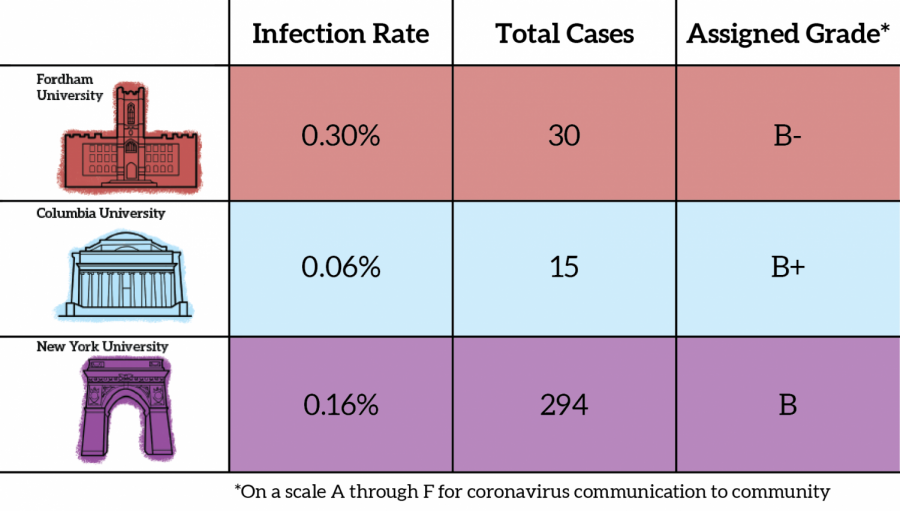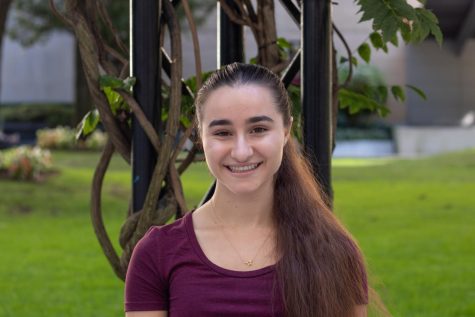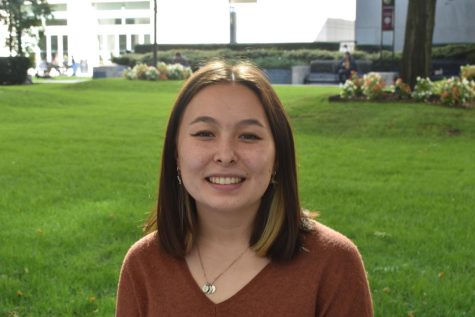Reopening in a Hotspot: Fordham’s COVID-19 Response Compared to Other NYC Schools
October 15, 2020
New York City’s COVID-19 hospitalizations are on the rise again after a period of low infection rates this summer, raising concerns of a “second wave.”
Schools in the city now have to make decisions about the upcoming spring semester under the possibility of a resurgence of the virus, while continuing to grapple with testing difficulties and a challenging online workload during the current semester.
On Oct. 8, University Provost Dennis C. Jacobs announced that Fordham students would be returning to campus for the spring semester and following a modified schedule “in anticipation of a national resurgence of the COVID pandemic this winter.”
College campuses are at the forefront of the conversation about safely operating amid the pandemic. According to The New York Times, there have been over 170,000 cases reported at more than 1,400 colleges nationwide.
In September, “We Rate Covid Dashboards,” a site created by medical professors that grades colleges around the country, gave Fordham an F, the lowest grade possible, for communication of coronavirus information to its community.
Two out of three colleges hosting in-person classes either have no testing plan or only test students who are showing symptoms.
Since the original posting, Fordham’s coronavirus dashboard grade has been increased to a B-. Columbia University earned a B+, and New York University (NYU) received a B, both ranking higher than Fordham.
Over the past two weeks, 10 Fordham students have tested positive for the virus — nine at Rose Hill and one at Lincoln Center, according to Fordham’s testing dashboard. Fordham’s infection rate is currently 0.3%, higher than both NYU’s most recent infection rate at 0.16% and Columbia’s at 0.06%.
Aiming to administer around 300 tests per day, Fordham has reported 30 total cases on campus out of roughly 13,000 undergraduate students.
In comparison, NYU has reported 294 COVID-19 cases out of roughly 58,500 students enrolled. Of those, 20 were confirmed in the last week. Unlike NYU, Fordham does not report its total infections to date on its website and only offers biweekly numbers.
NYU students living in the residence halls are required to undergo testing every week. Fordham’s mandatory testing is less frequent, with a total of four rounds across the entire fall semester. Although Columbia does not specify the frequency of mandatory testing on its website, a random sample of community members is contacted every week to undergo a repeat test.
In September, NYU suspended more than 20 students for breaking the school’s coronavirus policies. Fordham has not reported any disciplinary action taken against students for violating its COVID-19 policies, which are listed in the Ram Pledge.
Similar to the Ram Pledge, Columbia students had to sign the Columbia Community Health Compact before returning to campus. NYU does not have a contract for students to sign but does have a daily COVID-19 screener, similar to Fordham’s VitalCheck system.
Reports of parties hosted by Fordham students have also been circulating on social media — an anonymous submission Instagram account, @letstalkaboutitfordham, published two submissions on Oct. 13 highlighting Public Safety’s inefficiency in de-escalating and preventing parties hosted by members of the Fordham community, including Fordham sports teams.
Another Instagram account, @fordhamaccountability, was specifically created to hold students accountable for not wearing masks and properly social distancing.
With only a few weeks left until universities send students home in preparation for the spring semester, a report analyzed by NPR finds that two out of three colleges hosting in-person classes either have no testing plan or only test students who are showing symptoms.
According to Vivek Murthy, former U.S. surgeon general, the pandemic will most likely continue into 2022, indicating a need for more intentional planning. Experts have reported that up to 40% of people infected with the coronavirus do not show symptoms. It is suspected that the data colleges are reporting is not representative of the total number of cases on campus; the actual number of infected students may be higher than the published number.
Gabe Samandi contributed additional reporting to this story.

















